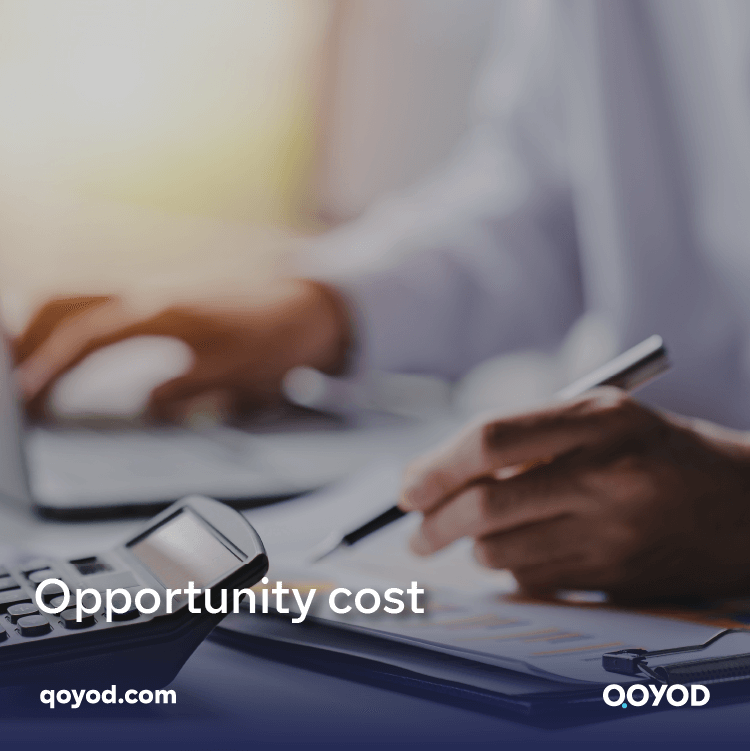Imagine that you are standing at a crossroads in your life, and each path leads to a different adventure, and each choice involves sacrificing one of the other paths and the opportunities and possibilities they may hold! This concept—both simple and exciting—is called opportunity cost. It is the hidden tool that shapes our daily decisions and determines how we use our time and resources to achieve the maximum possible benefit. So in this article, we will dive deep into this economic concept and discover how understanding it can change your view of the world around you and make every decision you make clearer and wiser. So follow along.
What does the opportunity cost mean?
Opportunity cost is defined as the value we lose when we choose one alternative over the other. In other words, it is the cost of the security we give up when we choose a particular option.
For example, if we have an amount of money and can invest it in two different projects, choosing one means sacrificing the potential benefits of the other. It is worth noting that this cost is not always financial, but rather it can be temporary or related to other resources.
How do we calculate the opportunity cost?
The opportunity cost formula is the difference between the expected return from the alternative option and the expected return from the chosen option, and it can simply be expressed by the following equation:
- Opportunity cost = return from opportunity lost minus return from opportunity chosen.
To illustrate this concept, let’s take the following example of a company facing two mutual choices:
- Option A: Invest excess capital in the stock market.
- Option B: Invest excess capital in her own business by purchasing new equipment to increase production.
Quantitative analysis
Assume that the expected return on investment in the stock market is 20% over the next year. In contrast, the company estimates that upgrading the equipment will generate a return of 16% over the same time period.
To calculate the opportunity cost of investing in equipment instead of the stock market, we use the above equation:
- Opportunity cost = 20% (return from the stock market) minus 16% (return from investment in equipment) = 4%.
Interpretation of the result
Based on the calculations, the opportunity cost of investing in equipment is 4%, so this means that the company will lose the opportunity to achieve a 4% higher return in the first year by choosing to invest capital in equipment instead of the stock market.
How does opportunity cost affect capital investment decisions?
Opportunity cost is a vital tool in the decision-making process because it helps investors evaluate the potential benefits and drawbacks of each investment alternative by:
Evaluate potential returns
When considering a capital investment, a company must balance the potential profits from the investment against the opportunity cost of investing in another project.
For example, if a company is considering building a new factory, it needs to compare the expected return from this factory with the expected return from any alternative investment that may be rejected in favour of the new factory. This helps ensure that resources are used in the most effective and profitable ways.
Identify the most profitable investment opportunities.
Opportunity costing allows investors to compare the potential returns of different projects and determine which ones may be more profitable. By comparing the potential returns, a company can better determine where it should invest its resources to achieve the greatest economic benefit.
Risk and return analysis
Using opportunity cost helps analyze both the risks and returns associated with each investment, as projects with high returns may come with high risks. By evaluating the opportunity cost, the company can determine whether the expected returns from the new investment are worth the risks associated with it compared to other options.
Practical applications of the impact of opportunity cost on capital investment decisions
Suppose a company has a certain amount of money and is considering investing it in either building a new factory or expanding an existing production line. The expected return from building the new factory is 10% per year, while the expected return from expanding the production line is 8% per year. The opportunity cost of building the new factory is the lost revenue from not expanding the production line, i.e., 8%.
If the company decides to build the new plant, it does so on the basis that the additional 2% return is worth the risks and costs associated with the new project. Likewise, if a third investment offers a 12% return, not choosing it would constitute a higher opportunity cost.
An example of the opportunity cost of business
Suppose a company has $25,000 in available funds and must choose between investing the money in a new technology project, which it expects to yield an 8% return annually, or using it to develop a new product. Regardless of which option the company chooses, the potential profit it gives up by not investing in the other option is the opportunity cost.
If the company decides to invest in the technology project, its investment would theoretically yield a profit of $2,000 in the first year, $2,160 in the second year, and $2,333 in the third year.
Alternatively, if the company uses the money to develop the new product, it will be able to increase its market share, knowing that developing and launching the product will require significant time and effort and that the new product will not reach maximum sales within the first two years. It is worth noting that the company estimates that it will achieve an additional net profit of $1,000 in the first year, then $3,000 in the second year, and $6,000 in all future years.
The result
Based on these calculations, the choice of technology project makes sense in the first and second years, but by the third year, the opportunity cost analysis indicates that new product development is the best option, and this can be calculated as follows:
- Profit from the technical project in the three years: $2000 + $2160 + $2333 = $6493.
- Profits from new product development in the three years: $1,000 + $3,000 + $6,000 = $10,000.
So, the opportunity cost of not choosing to develop the new product by year 3 is equal to:
- $10,000 minus $6,493 = $3,507.
It thus becomes clear that new product development is the best option for the company in the long run.
Example of opportunity cost analysis per capita
Individuals face decisions related to opportunity cost in various aspects of their daily lives, as this economic concept helps evaluate the available options and determine the most beneficial in the long term. So here we will review an example that shows how opportunity cost affects an individual’s decisions:
Scenario
Suppose you are a student about to graduate from university. You have two main options after graduation: The first is to accept a job offer with an annual salary of $50,000. The second option is to continue your studies for a master’s degree, which requires two years of study and costs $20,000 per year, with the promise of a future job with an annual salary of $70,000.
Opportunity cost analysis
If you decide to accept a job offer immediately after graduation, you will start earning $50,000 per year without delay; however, you will miss out on the opportunity to earn a higher salary in the future after obtaining your master’s degree.
If you choose to continue studying to obtain a master’s degree, you will bear the tuition costs amounting to $40,000 over the course of two years. Plus the opportunity cost of losing the income of $100,000 ($50,000 per year for 2 years) that you would have had if you were working, but after completing your studies, you will be eligible for a job with a salary of $70,000 per year, which is much higher than the starting salary.
calculation
- First decision: accept the job.
- Instant profit: $50,000 per year.
- Within two years: $100,000.
- Second decision: Continue studying.
- Cost: $40,000 (study costs).
- Loss of income: $100,000 (work salary over two years).
- Future Earnings: $70,000 per year after graduation
Evaluation
To calculate the net benefit of continuing the study:
- Total cost: $40,000 (tuition costs) + $100,000 (loss of income) = $140,000.
- Additional annual profit after graduation: $70,000 minus $50,000 = an additional $20,000 per year.
Assuming you work for 10 years after obtaining your master’s:
- Additional profit over 10 years: $20,000 x 10 = $200,000.
Conclusion
Although pursuing a study requires a large initial investment, future profits can offset these costs and achieve greater gains in the long term. By understanding the opportunity cost, individuals can make informed decisions that achieve a better balance between current costs and future gains.
The difference between opportunity cost and sunk cost
The difference between opportunity cost and sunk cost can be presented simply and clearly in the following table:
| The difference | Opportunity cost | Sunk cost |
| the definition | The potential returns that are not realized as a result of choosing another investment. | Money already spent in the past. |
| Time | Related to the future. | Related to the past. |
| Refund | It cannot be refunded because it has not yet been fulfilled. | It cannot be refunded because it has already been spent. |
| Examples | Choosing an alternative investment that could have yielded better returns. | The purchase of stock or equipment for a specified, non-refundable amount. |
| Financial decision | It helps in making better investment decisions. | They should be ignored when making future financial decisions. |
| in accounting | They are not recorded as losses because they have not occurred yet. | It may be consumed over the long term, but it is considered sunk because it was spent. |
| Impact on Budget | It does not directly affect the current budget. | It is recorded as an expense that may be significant and affect profits. |
| Evaluation in financial planning | Essential for financial planning and investment strategies. | It is not important for future financial planning. |
Advantages of using the Qoyod program regarding opportunity cost
This type of analysis requires effective tools for managing and analyzing data, such as the Qoyod accounting program, and by using this program, you will get many benefits, such as:
- Real-time financial data analysis: It allows obtaining real-time financial reports, which helps in making informed decisions.
- Cash Flow Management: Helps track cash inflows and outflows, allowing companies to identify investments that yield the highest return.
- Financial Planning and Budgeting: Provides tools for financial planning and budgeting that help companies better allocate their resources.
- Data integration: The program allows the integration of financial data from multiple sources, providing a comprehensive view of the company’s financial position.
- Strategic Forecasting and Analysis: It contains tools for financial forecasting and scenario analysis, which help in simulating the impact of different decisions on financial performance.
Conclusion
Opportunity cost remains a fundamental concept in both everyday and strategic decision-making, as understanding and applying it can be the difference between success and failure, both in our personal lives and in the business world. So always remember that every decision you make carries with it an invisible price, represented by the opportunities that you are forced to give up. So be careful in your calculations and thoughtful in your decisions, because success does not only require achieving goals; it also requires choosing the right goals that are worth sacrificing for.
Here it should be noted that the Qoyod program helps small and medium-sized companies make the right decisions in addition to providing electronic invoice systems, warehouses, customers, and so on.
After you know what the opportunity cost is, try Qoyod now for free for 14 days. It is an accounting program that will make you fly to the top.
Join our inspiring community! Subscribe to our LinkedIn page and Twitter to be the first to know about the latest articles and updates. An opportunity for learning and development in the world of accounting and finance. Don’t miss out, join us today!




